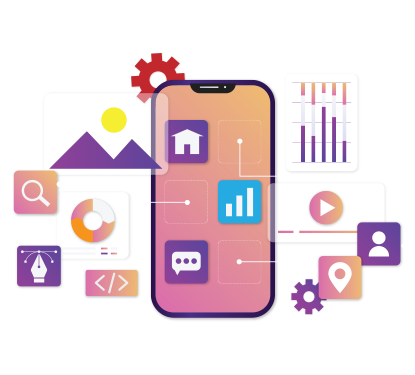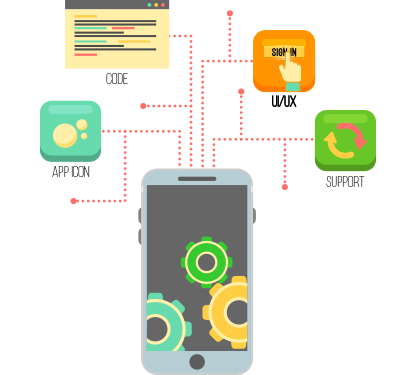Mobile Design & Development
Mobile App Design:- refers to the design of user interfaces for mobile devices, such as smartphones and tablets. The mobile design aims to create a user experience that is optimized for the smaller screen sizes and touch-based inputs of these devices. This often involves designing for a variety of screen sizes and orientations, as well as creating interfaces that are easy to navigate with a single finger. The mobile design also takes into consideration the limited processing power and battery life of mobile devices, as well as the need to provide a seamless experience across multiple devices and platforms.
Mobile App Development:- refers to the process of creating software applications and programs specifically designed for mobile devices such as smartphones and tablets. This can include creating native apps that are built specifically for a particular operating system (e.g. iOS or Android) or developing web-based applications that can be accessed through a mobile browser. Mobile development can also involve creating a responsive design for websites that allows them to be easily viewed and used on a mobile device. The goal of mobile development is to create applications and programs that are easy to use and provide a seamless user experience for users on the go.

Mobile App Design
• User experience: The design of the mobile app should be intuitive and easy to use, with a focus on providing a seamless and enjoyable experience for the user.
• Responsive design: The mobile app should be responsive, meaning it should adapt to the size and resolution of different devices, ensuring that it looks and functions properly on all devices.
• Simplicity: The mobile app should have a simple and straightforward design, with a clear and concise layout that is easy to navigate.
• Consistency: The design of the mobile app should be consistent throughout, with a consistent visual language, layout, and user interface.
• Branding: The mobile app should reflect the brand identity of the company, using consistent branding elements such as color, typography, and imagery.
• Visual design: The mobile app should have a visually appealing design, using a visually appealing color palette, typography, and imagery.
• Usability: The mobile app should be easy to use, with clear instructions and intuitive navigation.
• Accessibility: The mobile app should be accessible to all users, including those with disabilities, ensuring that it is usable by as many people as possible.
• Security: The mobile app should prioritize the security and privacy of the user, with robust security measures in place to protect sensitive data.
• Testing: The mobile app should be thoroughly tested to ensure that it is functional, reliable, and bug-free.
Mobile App Development
• Research and planning: Before beginning the development process, it is important to thoroughly research the market, target audience, and competitors to ensure the app will meet the needs and desires of users.
• Wireframing and prototyping: Wireframing and prototyping allow developers to create a visual representation of the app's user interface and user experience, helping to identify any potential issues before development begins.
• Cross-platform compatibility: In order to reach as many users as possible, it's important to consider developing for multiple mobile platforms, such as iOS and Android. This requires an understanding of the different platform-specific development tools and frameworks.
• Performance optimization: Mobile devices have limited resources compared to desktop computers, so it's important to optimize the app's performance to ensure that it runs smoothly and efficiently on a variety of devices. This includes optimizing for battery usage, memory consumption, and data usage.
• Security: Ensuring the security and privacy of user data is a top priority for mobile developers. This includes implementing measures such as encryption and secure authentication to protect against cyber threats.
• Integration with APIs: Many mobile apps rely on external APIs (Application Programming Interfaces) to access data and functionality from other platforms or services. Mobile developers need to be able to effectively integrate with these APIs to ensure a seamless user experience.
• Testing and debugging: Mobile apps can be prone to errors and bugs due to the wide range of devices and operating systems they may be used on. Mobile developers need to be proficient at testing and debugging their apps to ensure a high level of quality and stability.
• Maintenance and updates: Mobile apps require ongoing maintenance and updates to fix bugs, add new features, and keep up with evolving user needs and expectations. Mobile developers need to be prepared to continuously support and improve their apps to keep users engaged and satisfied.
• Collaboration: Mobile app development is often a team effort, requiring collaboration with designers, project managers, and other developers. Strong communication and collaboration skills are essential for mobile developers to work effectively in a team environment.
